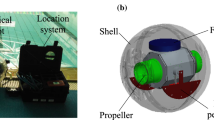Abstract
This paper presents the strategy of awakening a sphere robot from a sleep mode to a balancing mode. The sphere robot is designed on the basis of a single-wheel robot covered with two hemispheres to have the sphere shape with casters to maintain the sleep mode at a specific angle. The sleep angle has been empirically found to be 16 degrees for enabling the sphere robot to be upright position. The gyroscopic force is controlled to perform the awakening strategy of the robot system. Firstly, the key design features such as angular momentum, agility, and controllable bandwidth are investigated to identify three phases such as triggering, stumbling, and stabilizing for the awakening strategy. Secondly, the sphere robot is modeled as an inverted stick and the phase portrait of the model is analyzed. Thirdly, a control law with a compensation algorithm is proposed to enhance the stabilizing performance. Finally, the proposed awakening strategy is verified through experimental studies.
Similar content being viewed by others
References
Segway, http://segway.com
N. Hoa, M. John, and M. Katherine, “Segway robotic mobility platform,” Proc. SPIE 5609, Mobile Robots XVII, vol. 207, pp. 207–220, 2004.
R. P. M. Chan, K. A. Stol, and C. R. Halkyard, “Review of modeling and control of two–wheeled robots,” Annu. Rev. Control, vol. 37, no. 1, pp. 89–103, 2013.
Y. Takahashi, N. Ishikawa, and T. Hagiwara, “Soft raising and lowering of front wheels for inverse pendulum control wheel chair robot,” IEEE/RSJ International Conference on Intelligent Robots and Systems, vol. 4, pp. 3618–3623, 2003. [click]
T. Takaki, T. Aoyama, and I. Ishii, “Development of inverted pendulum robot capable of climbing stairs using planetary wheel mechanism,” ICRA, pp. 5618–5624, 2013.
K. Pathak, J. Franch, and S. K. Agrawal, “Velocity and position control of a wheeled inverted pendulum by partial feedback linearization,” IEEE Transactions on Robotics, vol. 21, no. 3, pp. 505–513, June 2005. [click]
C.–H. Huang, W.–J. Wang, and C.–H. Chiu, “Design and implementation of fuzzy control on a two–wheel inverted pendulum,” IEEE Trans. on Industrial Electronics, vol. 58, no. 7, pp.2988–3001, 2011. [click]
S. J. Lee and S. Jung, “Object handling control among two–wheel robots and a human operator: an empirical approach,” International Journal of Control, Automation, and Systems, vol. 11, no. 2, pp. 346–353, 2013. [click]
S. B. Cardini, “A history of the monocycle stability and control from inside the wheel,” IEEE Control Systems Magazine, vol. 26, no. 5, pp. 22–26, 2006.
J. O. Lee, S. I. Han, and J. M. Lee, “Decoupled dynamic control for pitch and roll axes of the unicycle robot,” IEEE Trans. on Industrial Electronics, vol. 60, no. 9, pp. 3814–3822, 2013. [click]
M.W. Spong, P. Corke, and R. Lozano, “Nonlinear control of the inertia wheel pendulum,” Automatica, vol. 37, no. 11, pp. 1845–1851, 2001. [click]
E. Mumm, K. Davis, M. Mahin, F. Neal, and R. Hayes, “Miniature Control Moment Gyroscope development,” IEEE Aerospace Conference, pp. 1–9, 2014.
Y. Xu, H. B. Brown, and K. W. Au, “Dynamic mobility with single–wheel configuration,” The International Journal of Robotics Research, vol. 18, no. 7, pp. 728–738, 1999.
Y. Ou and Y. Xu, “Stabilization and line tracking of the gyroscopically stabilized robot,” Proc. IEEE ICRA, vol. 2, pp.1753–1758, 2002. [click]
J. H. Park and S. Jung, “Development and control of a single–wheel robot: practical mechatronics approach,” Mechatronics, vol. 23, no. 6, pp. 594–606, 2013. [click]
S. D. Lee and S. Jung, “Experimental study and design of a disturbance observer for steering stabilization of a onewheeled balancing robot,” Journal of Institute of Control, Robotics and Systems, vol. 22, no. 5, pp. 353–360, 2016.
Y. Zhu, Y. Gao, C. Xu, J. Zjao, H. Jin, and J. M. Lee, “Adaptive control of a gyroscopically stabilized pendulum and its application to a single–wheel pendulum robot,” IEEE/ASME Trans. on Mechatronics, vol. 20, no. 5, pp. 2095–2106, 2015. [click]
J. H. Lee, H. J. Shin, and S. Jung, “Balancing control of a unicycle robot using ducted fans,” Journal of Institute of Control, Robotics and Systems, vol. 20, no. 9, pp. 895–899, 2014.
T. Insperger, “Stick balancing with reflex delay in case of parametric forcing,” Communications in Nonlinear Science and Numerical Simulation, vol. 16, no. 14, pp. 2160–2168, 2011.
L. Moreno–Ahedo, J. Collado, and C. Vazquez, “Parametric resonance cancellation via reshaping stability regions: numerical and experimental results,” IEEE Transactions on Control Systems Technology, vol. 22, no.2, pp. 753–760, 2014. [click]
H.W. Broer, I. Hoveijn, M. van Noort, and G. Vegter, “The inverted pendulum: a singularity theory approach,” Journal of Differential Equations, vol.157, no. 1, pp. 120–149, 1999.
Author information
Authors and Affiliations
Corresponding author
Additional information
Recommended by Associate Editor Kyu-Jin Cho under the direction of Editor Hamid Reza Karimi. This work has been supported by the National Research Foundation of Korea (NRF-2014R1A2A1A11049503 and 2016R1A2B2012031).
Sang-Deok Lee received his B.S. and M. S. degrees in Electronics Engineering from Cheonbuk National University, in 1998 and 2003, respectively. He joined LG Precision and Samsung Heavy Industries from 1998 to 2000 and from 2003 to 2014, respectively. He is currently a Ph.D. candidate in Department of Mechatronics Engineering at Chungnam National University. His research interests are Mechatronic system identification and control.
Seul Jung received the B.S. degree in Electrical and Computer Engineering from Wayne State University, Detroit, MI, USA in 1988, and the M.S. and Ph.D. degrees in Electrical and Computer Engineering from the University of California, Davis, in 1991 and 1996, respectively. In 1997, he joined the Department of Mechatronics Engineering, Chungnam National University, where he is presently a professor. His research interests include intelligent Mechatronics systems, intelligent robotic systems, mobile manipulators for home service applications, gyroscope applications, and robot education. He is a member of IEEE, ACA, ICROS, KROS, KIIS, KIEE, IEMEK, and IEEK.
Rights and permissions
About this article
Cite this article
Lee, S.D., Jung, S. Awakening strategies from a sleeping mode to a balancing mode for a sphere robot. Int. J. Control Autom. Syst. 15, 2840–2847 (2017). https://doi.org/10.1007/s12555-017-0007-4
Received:
Revised:
Accepted:
Published:
Issue Date:
DOI: https://doi.org/10.1007/s12555-017-0007-4




